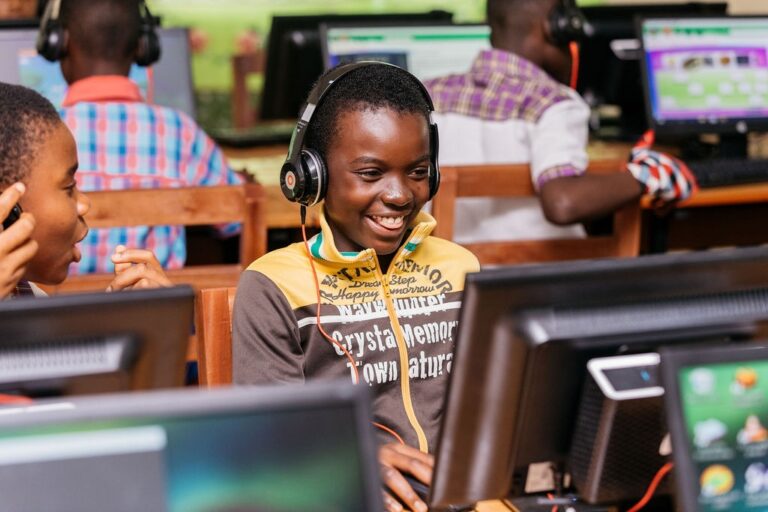This Sunday is International Father’s Day. What better time than this to shine the education spotlight on boys. Because, I’ll bet many of you do not know that there are just as many boys out of school as girls. While girls are less likely to enter school in the first place in many countries, a GEM Report paper, Don’t forget the boys, shows that boys are at a higher risk globally of not progressing and completing their education. They also perform less well in reading assessments worldwide. We won’t achieve gender equality in education if we ignore one half of the story.
While many of those used to hearing campaigners for girls’ education might be doubtful of the truth in this, the stats hold up. 132 million children out of school are girls, but 132 million are also boys. In 2016, 6% of countries had fewer boys than girls enrolling in primary, 17% in lower secondary and 45% in upper secondary. That year, there were 5 million more girls than boys out of school at primary level, but 2 million more boys than girls out of school at the lower-secondary level, and 4 million more men than women out-of-school at the upper-secondary level.
 These figures vary per region. Girls are at a distinct disadvantage from primary through to upper secondary school in sub-Saharan Africa, for example. Meanwhile boys are falling far behind in each of the education levels in Latin America and the Caribbean. In this region, for instance, for every 100 girls, 96 boys completed primary, 94 completed lower secondary, 91 completed upper secondary and only 83 were attending some form of post-secondary education.
These figures vary per region. Girls are at a distinct disadvantage from primary through to upper secondary school in sub-Saharan Africa, for example. Meanwhile boys are falling far behind in each of the education levels in Latin America and the Caribbean. In this region, for instance, for every 100 girls, 96 boys completed primary, 94 completed lower secondary, 91 completed upper secondary and only 83 were attending some form of post-secondary education.

Boys are disadvantaged at secondary and post-secondary levels in Latin America and Europe
In some countries, there have been some surprising changes. In India, Senegal, the Gambia, and Nepal, for example, where there were far fewer girls enrolled in secondary school than boys in 2000, the situation by 2016 had reversed leaving boys further behind. In some countries, such as Bangladesh, analysis shows that the reversal of the gender gap is, in part, because of the campaigns put in place to encourage girls to go to school.
 As our new paper shows, boys often drop out of school because of the necessity to work due to poverty. Even, in Italy, only 83 poor young men completed upper secondary school and only 66 poor men attended post-secondary education for every 100 poor young women.
As our new paper shows, boys often drop out of school because of the necessity to work due to poverty. Even, in Italy, only 83 poor young men completed upper secondary school and only 66 poor men attended post-secondary education for every 100 poor young women.
Socio-cultural perceptions of the role of boys among students, teachers and parents can also result in low expectations, disengagement from school and dropout. Boys are often more likely to experience corporal punishment than girls, for instance, which can lead them to drop out of school.
The GEM Report shows that ensuring both girls and boys complete at least secondary school is key for achieving gender equality across society. A survey in Brazil, Chile, Croatia, India and Rwanda showed that men who had not completed secondary education were more likely to express discriminatory views on gender. The survey showed that less educated men were also more likely to be physically or sexually violent in Bangladesh, Papua New Guinea, Indonesia and Cambodia. Paternal education is linked with stronger immunization uptake for children, even after taking maternal education into account.
 In short, we believe undoubtedly in the importance of improving girls’ education opportunities so that we can achieve gender equality in education. But pitting boys and girls against each other runs counter to an inclusive approach to education.
In short, we believe undoubtedly in the importance of improving girls’ education opportunities so that we can achieve gender equality in education. But pitting boys and girls against each other runs counter to an inclusive approach to education.
RECOMMENDATIONS
1. Be wary of streaming classes according to ability, which can disadvantage boys.
2. Avoid disciplinary practices such as banning class entry, suspension or expulsion, which have a negative impact on boys’ motivation to complete their schooling.
3. Reduce cost of schooling for poor households with conditional cash transfers, as has helped in Jamaica and Nicaragua.
4. Prioritise and promote boys’ reading and literacy skills with teaching and learning strategies that focus on active learning, and promote individual mentoring




![[Preliminary Report] CRNA Collaborative Research for Exploring Factors Nurturing"Happy and Resilient" Children among Asian Countries](https://equity-ed.net/wp-content/uploads/2024/09/1725672182698.jpg)

